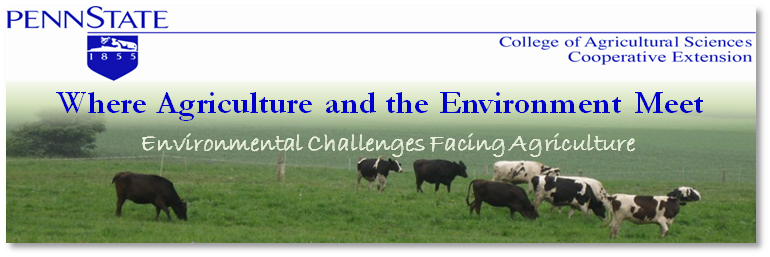December 21, 2009
Dairy to Reduce Green House Gases
December 14, 2009
Simple Steps to Deal With the Chesapeake Bay Regulations

I’ve been to a lot of meetings lately on the new Chesapeake Bay regulations and TMDLs (total maximum daily loads), which have been very informative, yet there are still a number of details that have to be worked out. However, one thing is very clear from these meetings, with EPA taking the lead there is a great deal of will to get the bay cleaned up for good. This is a watershed-wide initiative that includes six states and Washington D.C., but Lancaster County is, and will continue to be, an area of focus. At this point I see no need to panic, but awareness of the issues at hand and realizing that stricter regulations and enforcement of current laws is likely and may impact farms in the region is a good place to start. So what can you do to prepare your farm for these new regulations? First, check with your local conservation district to confirm what current rules and regulations are on the books that may apply to your farm. Second, I have listed four simple practices that can be taken that will give you a step ahead on these regulations, whatever they might be. These practices will also improve your farm management right now and may even improve your bottom-line.
1) Measure dry matter of wet forages weekly. If the dry matter on forages changes drastically and rations are not adjusted the nutrient content of the diet will also change. Therefore, you could be feeding more protein or other nutrients than the cow needs, which is not good for the environment or your feed costs.
2) Feed what is on the sheet. Nutritionists use very precise ration formulation programs and spend a lot of time developing rations. Intentional or unintentional deviations from the ration on paper can negatively impact milk production and nutrient utilization. Checking scales and monitoring mixing more closely are simply steps to address this problem.
3) Monitor milk urea nitrogen (MUN). Milk cooperatives can monitor MUN on the bulk tank, and DHIA can monitor MUN on individual cows. Regardless of what method you use to monitor MUN, it is a good measure of how well the cows are utilizing the protein in the ration. There can be a lot of variation in this number, but trends over time can be identified. Ration and feed management issues may need to be addressed if your farm consistently has high MUN. With protein being one of the most expensive nutrients in the ration this is a must.
4) Keep cows out of the streams. This is considered very low hanging fruit from a water quality standpoint and I don’t see anyway to get around this issue other than to fence cows out of the stream. Although the current regulations require extensive buffers (35-100 ft), I think we may get some compromise on this and just a few feet might be enough. Stay tuned on this issue.
These suggestions are relatively simple on paper, in practice they may be a little more complicated, but there is help. Penn State Extension and the local conservation districts have the expertise and the tools to help implement these new management practices. The reality is that water quality regulations will only get stricter, and like other regulations in the dairy industry, these will be what you need to do if you want to continue in the dairy business.
December 3, 2009
Swine and Poultry and Air Quality

I realized my dairy bias is really showing through in this blog so in an effort to try to expand my horizons I found a nice article on air quality concerns related to swine and poultry. This is another article from the Manure Du Jour series hosted last year. Another series of Manure Du Jour will be starting up again the first of the year so stay tuned for the schedule.
What are the major sources of greenhouse gas from swine and poultry operations?
The majority of methane and nitrous oxide from swine and poultry operations is emitted from buildings, manure storage, and land application of manure.
What strategies are available to reduce greenhouse gas?
A number of the strategies shown below reduce the potential for GHG emissions and in some cases, the amount of manure nutrients.
- Reducing the amount of waste excreted from the animal decreases the potential for formation of greenhouse gases during manure storage.
- Healthy herds use feed efficiently, and can reduce nitrogen excretion by ten percent compared to unhealthy herds.
- Animals with genetic lines predisposed to high feed efficiency also excrete fewer nutrients in urine and feces.
- Split-sex feeding enables producers to feed each sex closer to its nutritional requirements.
- Phase feeding allows producers to better match nutrients to the changing growth requirements.
- Enzymes, such as phytase, improve the digestibility of protein and reduce nitrogen excretion in manure. A low protein diet can reduce both fecal nitrogen and carbon dioxide production.
- Wet-dry feeders increase efficiency by reducing the amount of feed required to achieve a desired weight gain
What are the EPA reporting requirements for greenhouse gas from animal agriculture?
The Environmental Protection Agency has proposed national reporting of greenhouse gas emissions. Under these reporting requirements, large-, direct emitters of 25,000 metric tons of carbon dioxice equivalents or more must report GHG emissions to the EPA. Only emissions from manure management systems are expected to fall under these reporting requirements.
View the “Air Quality Nutrition and Greenhouse Gases” episode of Manure Du Jour on the Penn State Agriculture and Environment Web site: aec.cas.psu.edu/news/webinar_archives.asp. Special thanks are given to Dr. Wendy Powers, Departments of Animal Science and Biosystems and Agricultural Engineering, Michigan State University, for presenting the information on this topic.

